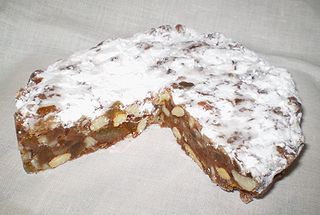
Dessert is a course that concludes a meal. The course consists of sweet foods, such as cake, biscuit, ice cream and possibly a beverage such as dessert wine and liqueur. Some cultures sweeten foods that are more commonly savory to create desserts. In some parts of the world there is no tradition of a dessert course to conclude a meal.

Turrón, torró or torrone is a Mediterranean nougat confection, typically made of honey, sugar, and egg white, with toasted almonds or other nuts, and usually shaped either into a rectangular tablet or a round cake. Turrón is usually eaten as a dessert food around Christmas in Spain and Italy.

Fruitcake or fruit cake is a cake made with candied or dried fruit, nuts, and spices, and optionally soaked in spirits. In the United Kingdom, certain rich versions may be iced and decorated.

A buccellato is a Sicilian circular cake made from pastry dough filled with figs and nuts. In Sicily, it is traditionally associated with Christmas.

Panforte is a chewy Italian dessert containing fruit and nuts. It is similar to a Florentine but is much thicker and is a little like a lebkuchen. Known throughout Italy, it is an Italian Christmas tradition associated especially with the province of Siena.

Christmas cake is a type of cake, often fruitcake, served at Christmas time in many countries.

Coda alla vaccinara is an oxtail stew in modern Roman cuisine including various vegetables, notably celery. The tail is considered offal, nicknamed in Rome the quinto quarto.

Cassata or cassata siciliana is an Italian cake originating in the Sicily region. It is typically composed of a round sponge cake moistened with fruit juices or liqueur and layered with ricotta cheese and candied fruit. It has a shell of marzipan, pink and green colored icing, and decorative designs. Cassata may also refer to a Neapolitan ice cream containing candied or dried fruit and nuts.

A marron glacé is a confection, originating in France or Italy consisting of a chestnut candied in sugar syrup and glazed. Marrons glacés are an ingredient in many desserts and are also eaten on their own.

Genoa cake is a fruit cake consisting of sultanas, currants or raisins, glacé cherries, almonds, and candied orange peel or essence, cooked in a batter of flour, eggs, butter, and sugar.

Zuccotto is an Italian dessert of Florentine origin. It is a semi-frozen, chilled dessert made with alchermes, cake, and ice cream. It can be frozen, then thawed before serving. Zuccotto is traditionally made in a special pumpkin-shaped mould. It is widely believed to have been inspired by the dome of Florence's duomo. Others allude to its shape as closely resembling a cardinal's skullcap or zucchetto.

The thirteen desserts are the traditional dessert foods used to celebrate Christmas in the French region of Provence. The "big supper" ends with a ritual 13 desserts, representing Jesus Christ and the 12 apostles. The desserts always number thirteen but the exact items vary by local or familial tradition. The food traditionally is set out Christmas Eve and remains on the table three days until December 27.

Succade is the candied peel of any of the citrus species, especially from the citron or Citrus medica which is distinct with its extra-thick peel; in addition, the taste of the inner rind of the citron is less bitter than those of the other citrus. However, the term is also occasionally applied to the peel, root, or even entire fruit or vegetable like parsley, fennel and cucurbita which have a bitter taste and are boiled with sugar to get a special "sweet and sour" outcome.
Florentine most commonly refers to:

A sweet roll or sweet bun refers to any of a number of sweet, baked, yeast-leavened breakfast or dessert foods. They may contain spices, nuts, candied fruits, etc., and are often glazed or topped with icing. Compared to regular bread dough, sweet roll dough generally has higher levels of sugar, fat, eggs, and yeast. They are often round, and are small enough to comprise a single serving. These differ from pastries, which are made from a paste-like batter; from cakes, which are typically unleavened or chemically leavened; and from doughnuts, which are deep fried.
Spongarda is a local cake originating in the comune (municipality) of Crema. The Lombardy region includes it as spongarda of Crema in the list of traditional food products.

Stuffed dates are boiled or heated dates filled with meat, mint and parsley, with different and modern stuffing including butters and goat cheese. In the Middle East and North Africa, fillings can include nuts, candied fruit, tahini, and cheese.
Emiko Davies is an Australia-born cookbook author, food journalist and food blogger, known for a focus on regional Italian food. She is based in Florence, Italy.















